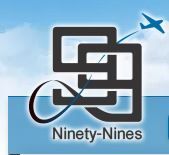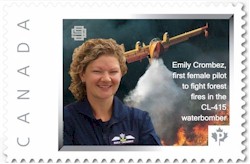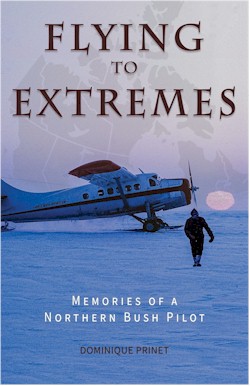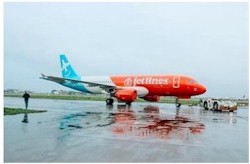|
You are heavy and slow, performing steep maneuvers, exercises you are usually taught to avoid." |
|
Click the image to open and view the YouTube video of the launch ceremony. Source: canadian99s.com/stamps |
|
|
|
Extracted from the 'Horizons' magazine. |
|
Issue dated June 2000 |
|
From an article by Mary Manni, Call Centre Coach & Counselor - Toronto. On June 16, 1995, Air Canada became the first North American operator of the Airbus A340-300 when it took delivery at the Paris Air Show. In the words of former Chairman, President, and Chief Executive Officer, Hollis L. Harris, "this ceremony marks the beginning of a new era in Air Canada's ability and comfort on long range routes." |
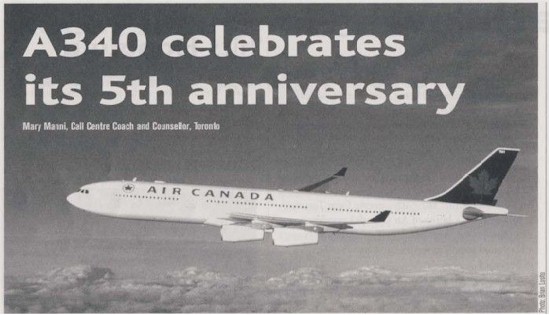 |
|
Pioneering pilots. Captains Cam Bailey, Chief Pilot, A340, and Gilles LaRue, Flight Manager, were the first pilots to fly Air Canada's A340-300. "The airplane smelled like a brand new car," says Bailey. "Before we flew it to Montreal, we stopped at Roissy-Charles de Gaulle Airport and loaded the belly up with cargo. The fleet works well and it's a terrific airplane to fly!" |
|
Valuable fleet member. Twelve aircraft and five years later, this four-engine long-range aircraft has proven to be a valuable addition to the fleet. The A340's state-of-the-art design makes it an environmentally friendly, cost and fuel efficient aircraft. This aircraft type has flown major long haul routes, such Vancouver-Osaka, Calgary-London Heathrow, Toronto-Tel Aviv, Toronto-Zurich, Montreal-Paris and, most recently, Toronto-Tokyo. |
|
Future orders. With new versions of the aircraft scheduled to enter the market in 2002, Air Canada has ordered two A340-500's and three A340-600's, with options for more. With a 7,600 mi (12,231 km) flying range, the -600 version can seat 360 customers and is designed for high density or slot constrained markets. With certification and entry into commercial service planned for the first half of 2002. Although Virgin Atlantic Airways will take delivery of the first aircraft, Air Canada's order will begin to arrive in March 2002. According to Airbus Industrie, the A340-500 can seat 308 passengers and fly up to 8,450 mi (3,599 km), making it one of the world’s longest range airliners. The first flight took place at the end of 2001 and entry into service is scheduled for the third quarter of 2002. In August 2002, Air Canada will become the first carrier to take delivery of the A340-500. "These types of aircraft help us offer customers more nonstop service on new routes across the Pacific and Europe," says Mike Hewitt, Director, Fleet Planning. "Once the A340-500 enters the fleet, we can begin to explore opportunities such as non-stops to India and South Africa, and from Vancouver to Singapore, Thailand, India and the South Pacific." |
|
Editors' Note: As is now known, plans for the A340 fleet did not materialize as projected. See 'What happened to Air Canada's Airbus A340's @ SimpleFlying.com. |
|
Found on the Nordair Facebook page -
Published by Hancock House Contains 280 pages, 180 colour pictures and 15 maps! Describing some of most memorable adventures and misadventures conducted in the Canadian Arctic with bush planes, “Flying to Extremes” covers the era of the late sixties and early seventies from a base at Yellowknife, Northwest Territories, Canada. Available in paperback from Amazon |
|
Canada Jetlines takes delivery of first aircraft.
For more info on the history and start up plans of Canada Jetlines, check out Alex Praglowski's YouTube video. |
|
The article regarding automated tickets in NetLetter #1477, and the comment by Doug Davidson that the audit coupon was like bank notes, brought back this memory for Terry Baker. When I was working for KLM Royal Dutch Airlines in London, as a lowly office boy in the late 1940's, one of my chores was to take coupons, which had been collected from other airline tickets, to the International Air Transport Association (IATA) clearing house for distribution to the airline involved. While working for the airline LIAT (1974) in Antigua, operating their computer section in 1978, I recall having to, occasionally, interpret a badly written audit coupon for the key entry person so that the details could be entered correctly. |
| Editors' Note: The original story was submitted by Mike Nash and appeared in NetLetter # 1475. |
|
Ed McManus recalls his experience with the 'short' DC-9 from NetLetter #1477 - During the time when the 'short' DC-9-14's were being returned to McDonnell Douglas, I was working in the autopilot section of the avionics shop (most called it the radio shop) at the Dorval Base. We had one autopilot that kept coming back with an intermittent problem that nobody could find and after a thorough bench test, it would be returned to our parts depot we called 'Stores'. After many return visits of this problem child, one of the foreman decided enough was enough. He took this headache and returned it to its mother who was leaving the next day for its birthplace. Ed McManus |

